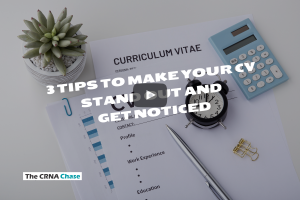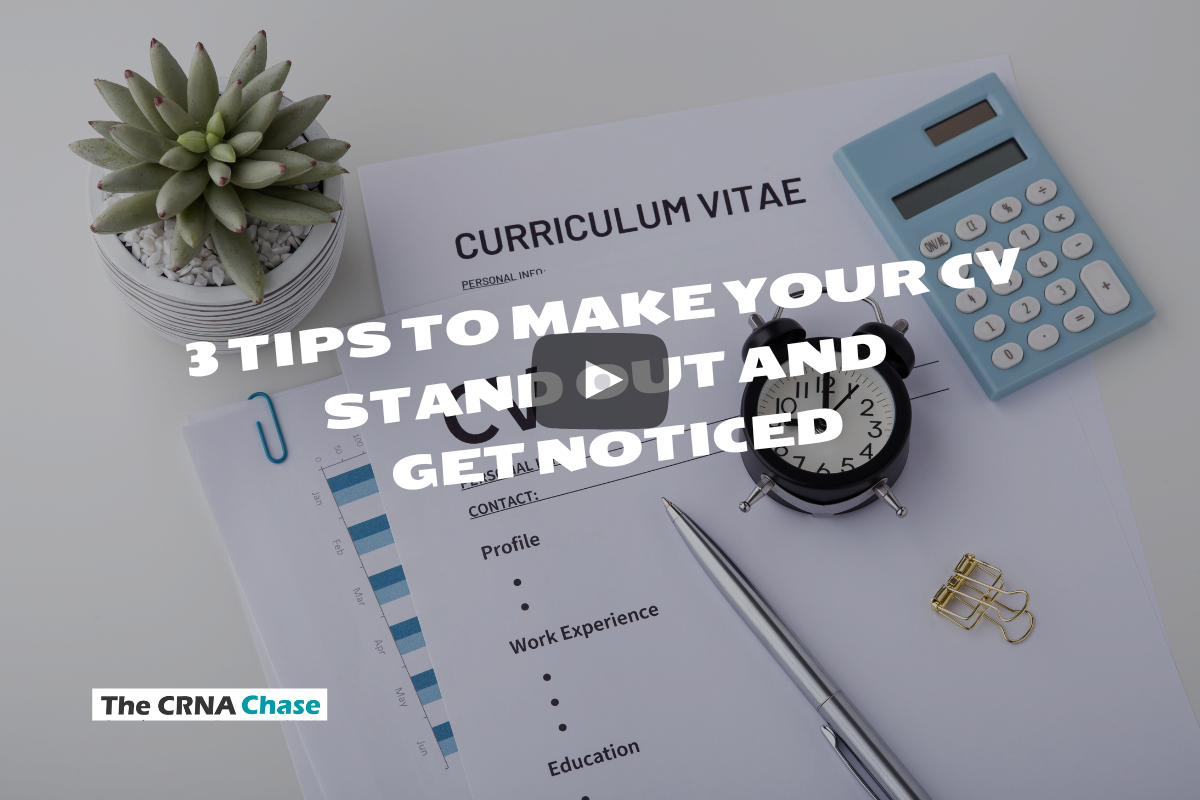Hello Future CRNAs,
I’m so excited to be here tonight. Been a while since I’ve done a live. You might have seen the actual E-mail I sent out saying I’m doing a live today and that I actually have COVID. I don’t feel great, but I thought, you know, this might be a good time to come try to come on and talk about CVs because I actually had someone reach out to a few days ago and wanted me to look at their CV.
So today we’re talking about how to make your CV stand out. Oftentimes you know the problem comes when you don’t know what to include in your CV. We feel like we don’t have time to focus on getting it done. It feels like we’re rushing to get it done. And we know that it needs to be really good to get past the admissions committee. So usually there are 3 frustrations. 1) I’m not sure what to include. 2) Feel like you don’t have time to focus on it and 3) you’re just not sure where to start.

CV vs. Resume
And because you do not create a CV often enough and the reason you really don’t create one often enough is because as nurses we actually put everything down on our CV the first time and we leave it and then apply to a job. Where we stay on their job for a number of years or unless you’re a travel nurse, you might update it more often, right? And so. I think what I would say about CVs is that most people don’t even know what a CV is. They get it confused with a resume. So, first thi thing I want you to do is stop calling it a resume and call it a CV, especially when you are talking to the admission committee. So, the difference between a CV and a resume is actually pretty simple. A CV is a curriculum vitae or which is Latin and it’s a summary of work and so it is a comprehensive review of everything you’ve done that is pertaining to the job that you’re trying to get or the position you’re trying to get.
So for example, for CRNA school, it would be your body of work that supports why you should get into CRNA school. It’s usually more than two pages, so a resume would be less than two pages, like one or two pages. Usually your CV, the longer the better is actually a good thing. You don’t want to turn in a one-page CV. I’m going to tell you right now, do not turn in a one-page CV. Unless that’s all you’ve ever done. And then if that’s the case, you probably need to get more experience and do more things because it really should be more than one- page. So again, that is just saying that a CV is your body of work, a comprehensive review that supports the position that you’re going for. Right. And So what you want to happen or what you want to see is that you want the CV to be simplified, right?
And most people just want to have a template where they just plug everything in and just go on about their business. A basic template or some people just want advice on what to include. Please just tell me what to do right? That is what most people would say. Just tell me what to include, right? So here are three ways that will make your CV stand out.
Format correctly
So, my first piece of advice is that your CV stands out automatically by formatting it correctly. Hey, so I’m going to give you some golden rules of formatting. First, you want to make sure it is legible and that it is easy to read, so you also want to have an easy-to-read font. And so that font would be like Arial font or Times New Roman font. So those are two really basic but easy-to-read fonts. Also, you want the heading where it is like your name and your address and your phone number. You want your name to be in 14 to 16 font and make sure it’s bolded. Address and phone number where you can be contacted easily. Your e-mail address should be like no type of nickname. It should be a professional type of e-mail address and so it shouldn’t say like numberoneprincessintheworld@gmail.com. It shouldn’t say anything like that. It should just be professional.
The rest of the CV font should not be too small or nothing too large, so maybe like a 10-11 font size. Again, Times New Roman or Arial font is fine. Make sure that your sections and fonts, all that is consistent. So what I mean by that is, let’s say that on the left justified side you have let’s say you have section headings on that side. For one section, you want to make sure all sections are left justified if you have the dates. So month and year on the right justified side for just one section, you want to make sure you do it for all the sections. So you want to just be consistent throughout. You also want to make sure that all the section headings clearly depict what’s underneath. So if you’re talking about your job? Your current job? You want to make sure that’s under work experience. So those are like some golden rules of formatting.
Remove irrelevant information
Now my second tip is that you want to remove any irrelevant information. That’s probably the biggest difference between a CV and a resume. A resume you tend to have all kinds of stuff, everything, you know, all little stuff here and there. For this though, we really going for nurse anesthesia, you know physician in the class, right? You want to remove irrelevant information in everything but education. So, for instance, I have a general engineering technology degree. I always include it under my education because I’m just super proud of my engineering technology degree, so I include it even if it has nothing to do with nurse anesthesia. But then again, maybe it does have something to do with nurse anesthesia because I took physics in engineering technology, and I took physics in nurse anesthesia, right? Well, like I had a portion of physics. It also shows that I was determined and I have these degrees. So I do not see any problem with you putting a degree there that’s not related to Nursing is what I’m trying to say.
Now under your work experience and all your other stuff in your CV, I would actually keep it relevant to nursing or critical care nursing, I should say that. You don’t want information in there that’s kind of depicts, like talks about your age or your ethnicity. But that’s going to be hard anyway, because what if you were part of a committee that was like a diversity committee that’s going to show that you’re probably non-white, right? What if you were part of the Hispanic community organization? Uhm, something like that? That would show that you’re probably Hispanic. So, it really kind of depends on what all you want to include if you feel like that would be a problem. I don’t of that should be a problem. You are who you are and that should never matter. But we know in this day and age sometimes that is not the case. So, you will just have to look at that however you want to look at it.
Show you’re an ICU nurse
Now my third tip is that your CV should actually scream ICU nursing when I look at your CV. It should not look like you’re just a floor nurse like it shouldn’t say I take care of patients in my unit. That tells me nothing about what you truly do. Under work experience, you should make mention of who you care for and then in the skills area you can include things like what you’re competent in. For instance, titration of drugs, vasopressors, hemodynamic monitoring, ECG monitoring, if you’re competent, any of that, you definitely want to include all of that. So, when I look at that CV, I’ll automatically know like, oh that is an ICU nurse right there. Like I can just tell by the wording that you’re an ICU nurse that just lets the committee keep reading, right there. So again, you could include those things like that under your work experience, or it could be in the skills area, or I’ve even seen it listed as RN competencies, which I thought was pretty cool. That’s really another way of saying skills.
Bottom Line
So just to recap. Here’s my advice on how to make your CV stand out. First, you want to make sure it’s formatted correctly. The biggest thing is making sure that it’s legible, making sure that it’s the font size is where you can read it. So, the two fronts that are commonly used are Arial font and Times New Roman. You also want to make sure that the font size for your name is between 14 to 16 and it’s bolded. But throughout the rest of the CV, you don’t want to be too small or too large, so about 10 to 12 font is fine. My second tip is that you want to remove irrelevant information and everything, but maybe the education is fine to list all your degrees if you want to. It’s fine. And then my third tip is your CV should scream ICU nursing, so under work experience. It definitely should be some mentioning about that. For instance, you may be a cardiovascular ICU registered nurse, so you want to make sure you spell that out and have that in there. You want to make mention of who you care for, so maybe you care for 1-2 patients in a such and such unit? And then in the skills area, you know that’s where you can make mention about how you titrate vasopressors and do ventilator management, hemodynamic monitoring, anything like that that you are confident in, right? So, those are my 3 tips on that.
Now I’m actually going to give you a couple of other pieces of advice just because it just came to me. If you put on your CV that you titrate drugs. If you put on your CV that you titrate any type of drug. Or that you do all this hemodynamic monitoring. Just make sure you know how to do those things because when you go for your interview, they pull all this information from your CV that you said you knew about. So don’t make up stuff and put it on your CV. If you’re kind of halfway like, I don’t know if I really know it, make sure you review it and get a grasp of it before you go for an interview. So that’s my tip on that. Also, if you have any questions, definitely let me know. Type in your question, I’m pretty sure I think I can see it here. I guess I can see it. If you have any questions, put that in. The comments and I’ll try to answer that right quick. Another piece of advice for your CV is to make sure that someone reviews your CV that you trust. That is really good at it. Don’t just let anybody look at your CV and give you feedback on it? Because this is very important. You really only have about 6 seconds to make a great first impression when someone is reading your CV. So, when the admissions committee is looking at your CV, you really only have like 6 seconds for them to be like, oh, OK, yeah, this is a go or no go right?
So, every time you submit your application to CRNA school, you’re basically going up against however many applicants that are vying for the same 20 or so seats in the program. Let’s say it’s 20 seats, it might be 200 applications. So, if you think about it like that, that’s a lot of people, right? So, imagine that you were the program director. Do you think that they have time to sit down and review 200 applications? Just thoroughly read 200 applications. No, of course not. Right? They don’t have time for that. So that’s why I say you only have 6 seconds, right? Usually what they’re looking for in those first few things that they start reading is did you follow directions and is it legible? Is it concise? Right. And so, when they see something different that doesn’t line up with what you know in their mind, they’re thinking always should be, it should be legible, it should be this. Ah, they Kick It Out. It’s really just that simple. So, all you have to do is make sure you start your CV off the right way and then. So, all you have to do is just follow the formatting right. Keep the formatting simple, clean, and concise and then they’ll keep reading. They like what you see, and like I said before, you know it.
So, if you’re overwhelmed and stressed with the whole CRNA school admissions process? I’m definitely looking to work with 1- 2 people in my mentorship program where if you need additional help and you don’t want to do this alone, definitely let me know. You can comment the word “program” or anything like that below. Now if you have any questions about your CV, definitely leave a comment or ask that question and I can try to help you with that. I hope you guys have a good rest of your day and I’ll see you at the next live training.







